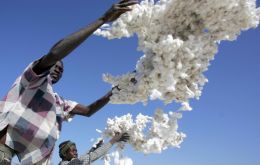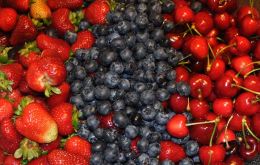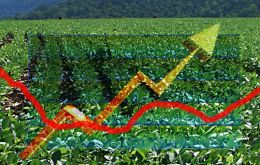MercoPress. South Atlantic News Agency
Agriculture
-
Tuesday, October 23rd 2012 - 07:01 UTC
Argentine with ‘clear long term policies’ can easily become the ‘Saudi Arabia of food’

Former Argentine central bank president, IMF economist and Bank of England consultant Mario Bléjer said that with clear long term policies Argentina could rapidly become the “Saudi Arabia of food” because food demand at world level will grow 20% in the next decade.
-
Thursday, October 18th 2012 - 10:41 UTC
Brazil-FAO sign agreement for cotton expertise transfer to small farmers in Africa

A 20 million dollars agreement signed Wednesday by the United Nations and Brazil will seek to transfer the expertise of the South American country to support cotton farmers in developing economies.
-
Thursday, October 18th 2012 - 10:33 UTC
Monsanto suspends collection of royalties in Brazil following state court ruling

Monsanto, the world’s biggest seed company, suspended collection of royalties for its Roundup Ready soybeans in Brazil while it appeals a state court ruling on intellectual property rights.
-
Wednesday, October 17th 2012 - 15:16 UTC
Is Brazil the reservoir of future agriculture productive capacity?

The following piece was published by Dorvers, CattleNnetwork and refers to the agriculture potential of Latinamerica and Mercosur largest economy. The column sources are Daryll E. Ray and Harwood D. Schaffer, Agricultural Policy Analysis Center, University of Tennessee, Knoxville, TN.
-
Thursday, October 11th 2012 - 05:26 UTC
Seed giant Monsanto suspended in Argentina on allegations of tax irregularities

Argentine authorities suspended the local unit of US seed giant Monsanto from a local grains registry over allegations of tax irregularities. The company denied the allegations in a statement issued late on Wednesday.
-
Tuesday, October 9th 2012 - 10:48 UTC
Brazil and Argentina mend trade fences: end to impediments for fruit and pork

Brazil announced on Monday it had fully restored agriculture trade with Argentina which means there should be no further impediments or red tape for Argentine fruit or for Brazilian pork.
-
Monday, October 8th 2012 - 20:43 UTC
Paraguay expects 9.5% expansion next year propped by a ‘super soybean crop’

Paraguay’s economy is forecasted to contract 1.5% in 2012 but in 2013 will soar 9.5% based on a “super soybean crop” and the recovery of other sectors, according to the latest report from the country’s Central bank confirming its previous 2012 GDP estimate.
-
Friday, October 5th 2012 - 22:55 UTC
Brazil September inflation higher on food prices, but bank could further cut Selic rate

September inflation in Brazil was up 0.57% on higher food prices according to the latest release from the country’s stats office, IBGE. This was the highest rate since last April (0.64%) and the steepest for September since 2003, (0.78%).
-
Friday, October 5th 2012 - 22:47 UTC
Decline in Canada’s canola crop impacts on oilseed markets

Chicago soybean futures edged higher on Friday, building on the last two sessions of gains with support from a revival in US exports and a surprise decline in estimates for Canada's canola crop.
-
Thursday, October 4th 2012 - 19:52 UTC
FAO Prices Index up 1.4% in September pushed by dairy and meats

Following two months of stability, the FAO Price Index rose slightly in September 2012, up 1.4%, or 3 points, from its level in August. The Index, based on the prices of a basket of internationally traded food commodities, climbed to 216 points in September from 213 points in August.